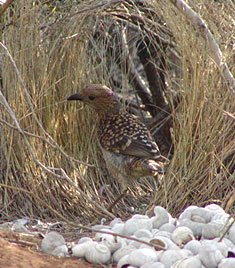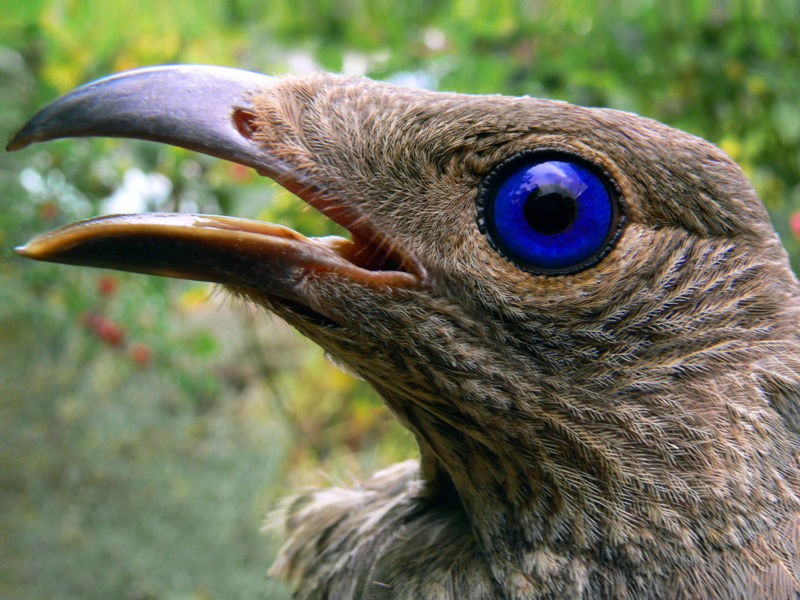Bowerbirds: Nature's Interior Designers
Biology 342 Fall 07
Valerie Conrad and Hannah Smith
Phylogeny
The Evolution of a Bower: Sexual Selection leads to Diversity
 [2]
[2]
Different species of bowerbirds demonstrate different levels of complexity in their bowers, both in construction and ornamentation. The level of craftsmanship put into the bower ranges from the lowest level-- catbirds of the genus Ailuroedus that do not construct a bower at all-- to the highest degree of ornamentation, such as the hut bowers of certain Amblyornis inornatus populations, which consist of a woven stick hut, intricately decorated with brightly colored objects precisely positioned. Intermediate bowers can consist of simple cleared display courts, platforms of plant matter, avenues enclosed by two parallel stick walls (as in the above photo), or maypole bowers of saplings encircled with woven twigs and ornaments.
It has been proposed that preexisting criteria were necessary for the development of bower building as a main form of sexual display. To afford to spend a great deal of time and effort constructing and maintaining a bower, it is essential that males expend no energy in the care of the young. Female bowerbirds raise the young unaided, with no input from the male after copulation, freeing him from responsibility. This independence could be due to the relative abundance of resources in the bowerbirds’ habitat and to high instances of nest predation, in which the only defense is concealment and an additional adult would simply call more attention to the nest site.
The evolution of bower-building behavior is believed to be strongly driven by sexual selection, due to the fact that bowers serve both as a criterion by which females judge male attractiveness, and as an arena for the male to perform his courtship display. Bowers appear to be an honest indicator of good genes, due to the skill and strength required to obtain materials, construct a bower often multiple feet high, and defend it from theft and destruction. Female birds will inspect multiple bowers and observe many male display rituals throughout the mating season before choosing a single mate, often causing a few individual males to mate with the vast majority of the females. A large proportion of male bowerbirds fail to procure even a single mating in a given season, leading to rapid divergence in bower style due to extreme sexual selection.
 [3]
[3]
Female satin bowerbird
Because only the minority of bowerbird males with the most elaborate and attractive bowers mate during each breeding season, populations become reproductively isolated very rapidly, as divergent groups of females select for widely different bowers. Only a specific style of bower displaying a high quality of construction and decoration will result in consistent mating success, with female bowerbirds showing no interest in bowers differing from the standard type of their population. As a result, differing populations of the same species will show a variety of bowers and displays, with no evidence of interbreeding, and despite minimal genetic differentiation. This type of self-imposed reproductive isolation may lead to speciation, despite the populations having close geographical proximity.
It is difficult to trace the phylogenetic history of bower type and complexity due to the rapidity with which styles of bower diverge. Attempts to use plumage and bower style to trace phylogenetic relationships within the family have determined that there is little correlation between plumage and display and the genetic relatedness of bowerbird species (Kusmierski et. al.). Selection for bower type appears to be driven by female preference, a quality which can vary widely both inter- and intraspecifically. The evolution of unique forms of bower construction and ornamentation is therefore a product of diverging female attraction to various bowers, causing stringent sexual selection for increasingly elaborate and specific bowers.